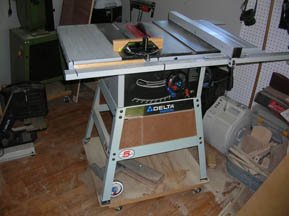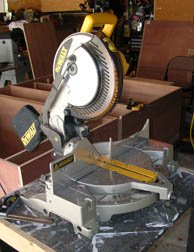|
Power Tools"You can cuss about that thing once or cuss at it every time you use it." The quote above refers to buying good versus so-so equipment. Spend what you can afford to get the best you can. Use common sense when shopping for tools. Heavier power tools tend to operate with less vibration, guide fences should have a solid feel when engaging, positioning controls should be easy to reach, understandable, and smooth moving. For our purposes, power tools consist of the large, stationary tools that are not hand held. These tools will add efficiency and accuracy to your woodworking. They will also eat up some cash and space. West Hills Wood bought a Delta 10-inch table saw a few years ago for a window frame project at the house. Knowing we had to build frames for 17 windows, it was a good time to fork over the $300. Lacking room enough for a permanent location, we put wheels on it and stored it out back in the bicycle shed when not in use. 
A small, decent table saw can still be had for around $300. It should come with a miter guide and sturdy rip fence. Three varieties are out there. Benchtop versions are good for mobility and light work, but if you are expecting to be at this game for awhile, you will outgrow it pretty quick. Contractor's saws are a step up and should come with a cast iron table, supporting stand, and optional side extension table. For those willing to go big, cabinet saws are heavier, smoother operating, more powerful, and easier to adjust. For our needs, a contractor's saw fits well and is what we recommend to beginners. Direct vs belt drive systems have pros and cons. Don't let one sway you over the other. Should you ever decide to step up to a cabinet saw, you will have the benefit of experience when shopping. The exposed blade rotates with ferocity and will make quick, accurate work for you. Always use a the rip fence or miter gauge when cutting. This is not a free-hand machine. Be aware that a table saw does not distinguish between fingers and wood. Also consider purchasing a chop saw. Also known as a compound miter saw, this baby will provide you with reliable cuts on multiple angles for many years. It is often more convenient to use than a table saw and compliments it well. 
We recommend buying a miter saw that not only has a pull-down cutting action, but also slides. West Hills Wood has gotten a lot of use out of our pull-down DeWalt, but often find ourselves wanting for the increased capacity of a slider. It will cost you nearly twice for a slider over the pull-down, but spend the cash (or withhold the purchase until you can get the slider) and don't look back. Other power tools to consider are a drill press (about $300 for a floor standing model, $75 for a bench top model), band saw (don't get anything under 14 inches), and a bench top disk sander. There are many tool options and choices. For the beginning woodworker ready to take a step up and make some cash investments in the game, a contractor's table saw and compound miter saw should be top of the power tools list.
|
